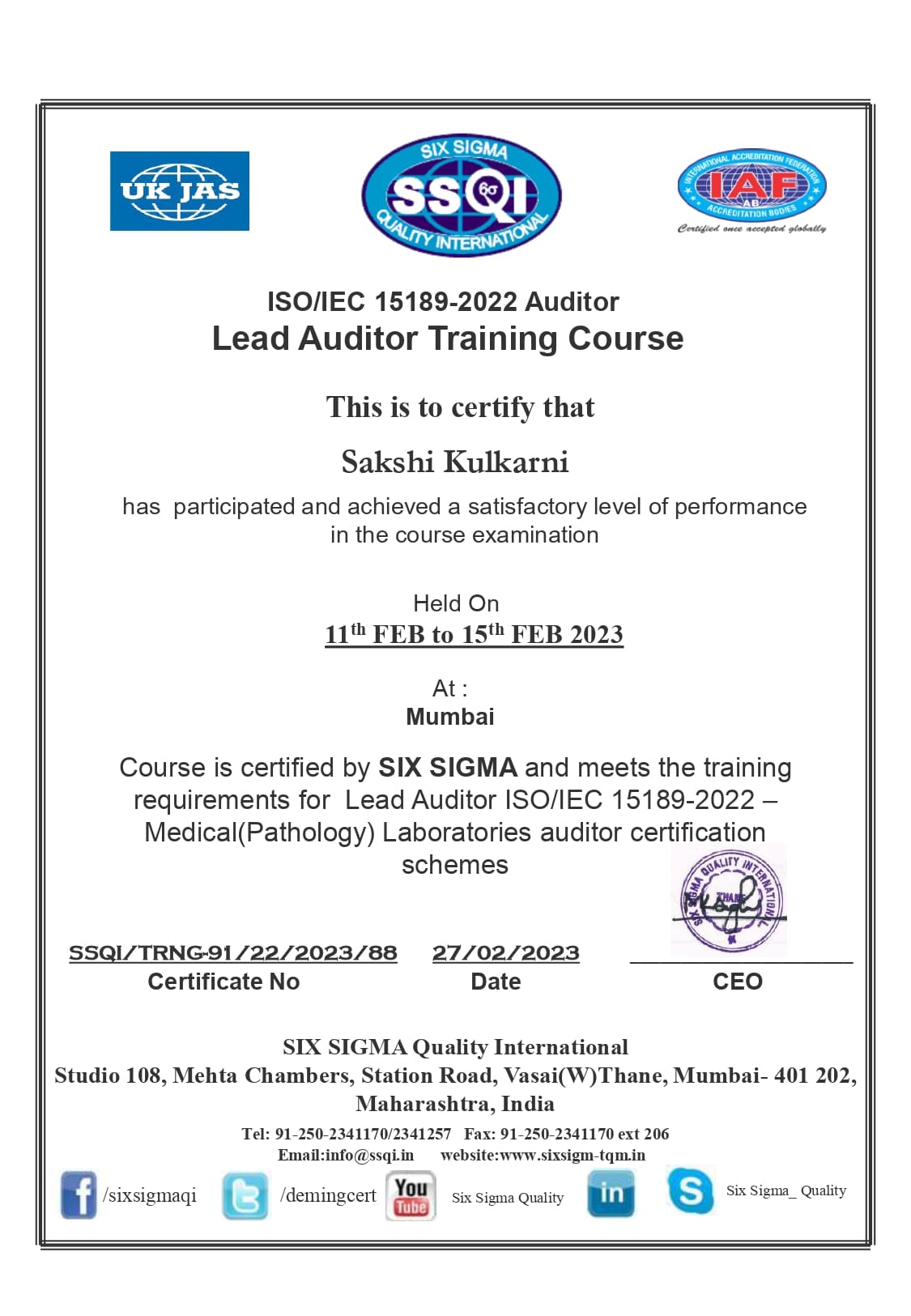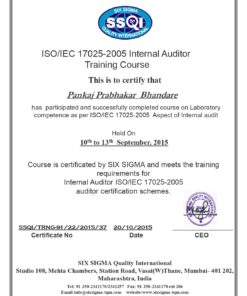Lead Auditor Training On ISO 15189 Pathology Lab
₹30,000.00 Original price was: ₹30,000.00.₹15,000.00Current price is: ₹15,000.00.
What they will gain:
Higher Effectiveness and Efficiency on their Job Excellent
Career Enhancement Opportunity Internationally Recognized Qualification
Photo-identity Card from ASCB(Europe) Ltd. – UK Listing among an International list of Quality Professionals.
Course is Accredited by ASCB(UK). system requirements particular to medical laboratories. The standard was developed by the International Organization for Standardization’s Technical Committee 212 (ISO/TC 212). ISO/TC 212 assigned ISO 15189 to a working group to prepare the standard based on the details of ISO/IEC 17025:1999 General requirements for the competence of testing and calibration laboratories. This working group included provision of advice to users of the laboratory service, the collection of patient samples, the interpretation of test results, acceptable turnaround times, how testing is to be provided in a ISO 15189 Medical laboratories – Particular requirements for quality and competence specifies the quality management medical emergency and the lab’s role in the education and training of health care staff.
ISO 15189:2007 Introduction:
ISO 15189:2007:
ISO 15189:2003 is an international standard developed particularly for the medical laboratories. Though it is based upon ISO/IEC 17025:1999 and ISO 9000:2000, it is a standalone standard for medical laboratories with a title particularly referred to “quality and competence”. Under the International Laboratory Accreditation Cooperation (ILAC) Multilateral Mutual Recognition Arrangement (MLA)accreditation of medical laboratories against ISO 15189 and ISO/IEC 17025 are both acceptable.
The basic idea of the European Union is freedom of movement of people, products and services. This is realized through harmonization of practices, for example in the field of laboratory medicine, a patient wants to be sure that the result of a test can be trusted and is interpreted in the right way during his stay abroad.The primary aims of both Evidence-based Health Care (EBHC) and quality management of health care services are to improve clinical effectiveness and patients’ outcomes. Evidence-based laboratory medicine (EBLM) is an essential tool in the assessment of effectiveness, as high quality systematic clinical research is necessary for investigating the impact of any intervention on clinical outcome.
Implementing ISO 15189 as part of laboratory quality initiatives provides both laboratory and business benefits such as:
· Improved national and global reputation and image of the laboratory.
· Continually improving data quality and laboratory effectiveness.
· Having a basis for most other quality systems related to laboratories, such as Good Laboratory Practices.
· Mutual Recognition Agreement (MRA) amongst various countries test report is acceptable without repetition of analysis.
To become a lead auditor for ISO 15189 in a pathology lab, you’ll need to undergo specific training and certification. ISO 15189 is an international standard that specifies requirements for competence and quality in medical laboratories. Here’s a general outline of the steps you might take:
- Understand ISO 15189: Familiarize yourself with the ISO 15189 standard and its requirements for medical laboratories. This involves studying the standard document thoroughly to understand its clauses, principles, and implementation guidelines.
- Gain Relevant Experience: Before pursuing lead auditor training, it’s beneficial to have experience working in pathology labs or in a quality management role within healthcare settings. This experience will provide you with the necessary context to understand how ISO 15189 principles apply in real-world scenarios.
- Attend Lead Auditor Training Course: Look for training courses specifically tailored to ISO 15189 lead auditor certification. These courses are typically offered by certified training providers and cover topics such as quality management systems, auditing techniques, and ISO 15189 requirements. Make sure the course you choose is recognized and accredited.
- Participate in Practical Exercises: Many lead auditor training courses include practical exercises and simulations to help participants apply auditing principles in a laboratory setting. These exercises can provide valuable hands-on experience and help you understand how to conduct audits effectively.
- Pass the Certification Exam: After completing the training course, you’ll likely need to pass a certification exam to become a certified ISO 15189 lead auditor. The exam may test your understanding of the standard, auditing techniques, and your ability to apply ISO 15189 requirements in practice.
- Gain Audit Experience: Once certified, gaining practical audit experience is essential for becoming proficient as a lead auditor. This may involve participating in audits under the guidance of experienced auditors or leading audits yourself under supervision until you’re confident in your abilities.
- Maintain Certification: ISO certifications typically require ongoing maintenance to ensure that auditors stay up-to-date with changes to the standard and continue to demonstrate competency. This may involve attending refresher courses, participating in continuing education, or fulfilling other requirements set by the certifying body.
- Continuous Improvement: As with any professional certification, continuous improvement is key. Stay informed about developments in the field of medical laboratory quality management and seek opportunities to enhance your skills and knowledge through training, conferences, and networking with peers in the industry.
By following these steps, you can work towards becoming a qualified lead auditor for ISO 15189 in pathology laboratories and contribute to ensuring quality and competence in medical laboratory services.
Be the first to review “Lead Auditor Training On ISO 15189 Pathology Lab” Cancel reply
Related products
Internal Auditor Training Service



Reviews
There are no reviews yet.